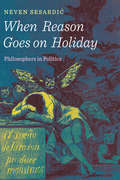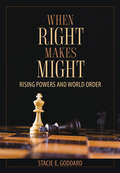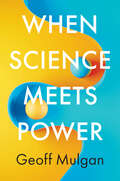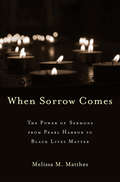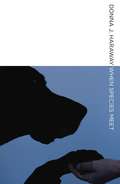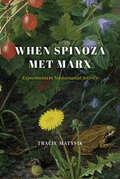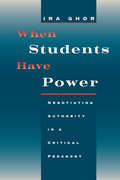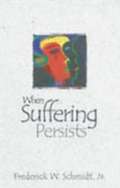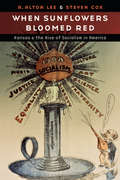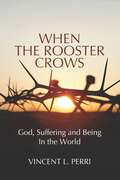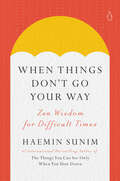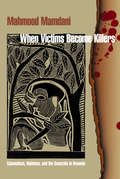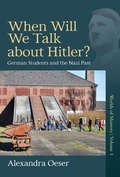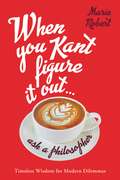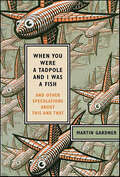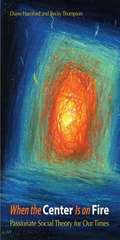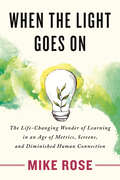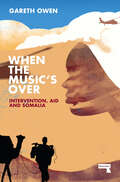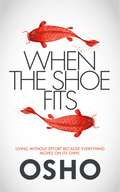- Table View
- List View
When Reason Goes on Holiday: Philosophers in Politics
by Neven SesardicPhilosophers usually emphasize the importance of logic, clarity and reason. Therefore when they address political issues they will usually inject a dose of rationality in these discussions, right?Wrong. This book gives a lot of examples showing the unexpected level of political irrationality among leading contemporary philosophers. The body of the book presents a detailed analysis of extreme leftist views of a number of famous philosophers and their occasional descent into apology for-and occasionally even active participation in-totalitarian politics. Most of these episodes are either virtually unknown (even inside the philosophical community) or have received very little attention.The author tries to explain how it was possible that so many luminaries of twentieth-century philosophy, who invoked reason and exhibited rigor and careful thinking in their professional work, succumbed to irrationality and ended up supporting some of the most murderous political regimes and ideologies. The huge leftist bias in contemporary philosophy and its persistence over the years is certainly a factor but it is far from being the whole story.Interestingly, the indisputably high intelligence of these philosophers did not actually protect them from descending into political insanity. It is argued that, on the contrary, both their brilliance and the high esteem they enjoyed in the profession only made them more self-confident and less cautious, thereby eventually making them blind to their betrayal of reason and the monstrosity of the causes they defended.
When Right Makes Might: Rising Powers and World Order (Cornell Studies in Security Affairs)
by Stacie E. GoddardWhy do great powers accommodate the rise of some challengers but contain and confront others, even at the risk of war? When Right Makes Might proposes that the ways in which a rising power legitimizes its expansionist aims significantly shapes great power responses. Stacie E. Goddard theorizes that when faced with a new challenger, great powers will attempt to divine the challenger’s intentions: does it pose a revolutionary threat to the system or can it be incorporated into the existing international order? Goddard departs from conventional theories of international relations by arguing that great powers come to understand a contender’s intentions not only through objective capabilities or costly signals but by observing how a rising power justifies its behavior to its audience. To understand the dynamics of rising powers, then, we must take seriously the role of legitimacy in international relations.A rising power’s ability to expand depends as much on its claims to right as it does on its growing might. As a result, When Right Makes Might poses significant questions for academics and policymakers alike. Underpinning her argument on the oft-ignored significance of public self-presentation, Goddard suggests that academics (and others) should recognize talk’s critical role in the formation of grand strategy. Unlike rationalist and realist theories that suggest rhetoric is mere window-dressing for power, When Right Makes Might argues that rhetoric fundamentally shapes the contours of grand strategy. Legitimacy is not marginal to international relations; it is essential to the practice of power politics, and rhetoric is central to that practice.
When Science Meets Power
by Geoff MulganScience and politics have collaborated throughout human history, and science is repeatedly invoked today in political debates, from pandemic management to climate change. But the relationship between the two is muddled and muddied. Leading policy analyst Geoff Mulgan here calls attention to the growing frictions caused by the expanding authority of science, which sometimes helps politics but often challenges it. He dissects the complex history of states’ use of science for conquest, glory and economic growth and shows the challenges of governing risk – from nuclear weapons to genetic modification, artificial intelligence to synthetic biology. He shows why the governance of science has become one of the biggest challenges of the twenty-first century, ever more prominent in daily politics and policy. Whereas science is ordered around what we know and what is, politics engages what we feel and what matters. How can we reconcile the two, so that crucial decisions are both well informed and legitimate? The book proposes new ways to organize democracy and government, both within nations and at a global scale, to better shape science and technology so that we can reap more of the benefits and fewer of the harms.
When Sorrow Comes: The Power of Sermons from Pearl Harbor to Black Lives Matter
by Melissa M. MatthesSince World War II, Protestant sermons have been an influential tool for defining American citizenship in the wake of national crises. In the aftermath of national tragedies, Americans often turn to churches for solace. Because even secular citizens attend these services, they are also significant opportunities for the Protestant religious majority to define and redefine national identity and, in the process, to invest the nation-state with divinity. The sermons delivered in the wake of crises become integral to historical and communal memory—it matters greatly who is mourned and who is overlooked. Melissa M. Matthes conceives of these sermons as theo-political texts. In When Sorrow Comes, she explores the continuities and discontinuities they reveal in the balance of state power and divine authority following the bombing of Pearl Harbor, the assassinations of JFK and MLK, the Rodney King verdict, the Oklahoma City bombing, the September 11 attacks, the Newtown shootings, and the Black Lives Matter movement. She argues that Protestant preachers use these moments to address questions about Christianity and citizenship and about the responsibilities of the Church and the State to respond to a national crisis. She also shows how post-crisis sermons have codified whiteness in ritual narratives of American history, excluding others from the collective account. These civic liturgies therefore illustrate the evolution of modern American politics and society. Despite perceptions of the decline of religious authority in the twentieth century, the pulpit retains power after national tragedies. Sermons preached in such intense times of mourning and reckoning serve as a form of civic education with consequences for how Americans understand who belongs to the nation and how to imagine its future.
When Species Meet (Posthumanities #3)
by Donna J. HarawayIn 2006, about 69 million U.S. households had pets, giving homes to around 73.9 million dogs, 90.5 million cats, and 16.6 million birds, and spending more than 38 billion dollars on companion animals. As never before in history, our pets are truly members of the family. But the notion of &“companion species&”—knotted from human beings, animals and other organisms, landscapes, and technologies—includes much more than &“companion animals.&”In When Species Meet, Donna J. Haraway digs into this larger phenomenon to contemplate the interactions of humans with many kinds of critters, especially with those called domestic. At the heart of the book are her experiences in agility training with her dogs Cayenne and Roland, but Haraway&’s vision here also encompasses wolves, chickens, cats, baboons, sheep, microorganisms, and whales wearing video cameras. From designer pets to lab animals to trained therapy dogs, she deftly explores philosophical, cultural, and biological aspects of animal–human encounters. In this deeply personal yet intellectually groundbreaking work, Haraway develops the idea of companion species, those who meet and break bread together but not without some indigestion. &“A great deal is at stake in such meetings,&” she writes, &“and outcomes are not guaranteed. There is no assured happy or unhappy ending-socially, ecologically, or scientifically. There is only the chance for getting on together with some grace.&”Ultimately, she finds that respect, curiosity, and knowledge spring from animal–human associations and work powerfully against ideas about human exceptionalism.
When Spinoza Met Marx: Experiments in Nonhumanist Activity (The\life Of Ideas Ser.)
by Tracie MatysikExplores concepts that bring together the thinking of Spinoza and Marx. Karl Marx was a fiery revolutionary theorist who heralded the imminent demise of capitalism, while Spinoza was a contemplative philosopher who preached rational understanding and voiced skepticism about open rebellion. Spinoza criticized all teleological ideas as anthropomorphic fantasies, while Marxism came to be associated expressly with teleological historical development. Why, then, were socialists of the German nineteenth century consistently drawn to Spinoza as their philosophical guide? Tracie Matysik shows how the metaphorical meeting of Spinoza and Marx arose out of an intellectual conundrum around the meaning of activity. How is it, exactly, that humans can be fully determined creatures but also able to change their world? To address this paradox, many revolutionary theorists came to think of activity in the sense of Spinoza—as relating. Matysik follows these Spinozist-socialist intellectual experiments as they unfolded across the nineteenth century, drawing lessons from them that will be meaningful for the contemporary world.
When Students Have Power: Negotiating Authority in a Critical Pedagogy
by Ira ShorWhat happens when teachers share power with students? In this profound book, Ira Shor—the inventor of critical pedagogy in the United States—relates the story of an experiment that nearly went out of control. Shor provides the reader with a reenactment of one semester that shows what really can happen when one applies the theory and democratizes the classroom. This is the story of one class in which Shor tried to fully share with his students control of the curriculum and of the classroom. After twenty years of practicing critical teaching, he unexpectedly found himself faced with a student uprising that threatened the very possibility of learning. How Shor resolves these problems, while remaining true to his commitment to power-sharing and radical pedagogy, is the crux of the book. Unconventional in both form and substance, this deeply personal work weaves together student voices and thick descriptions of classroom experience with pedagogical theory to illuminate the power relations that must be negotiated if true learning is to take place.
When Suffering Persists
by Frederick W. SchmidtIn this book, Frederick W. Schmidt presents a pastoral exploration of ways to understand suffering theologically, offering an approach that ministers to both mind and spirit. He questions the value of our usual comforting words and examines the pat explanations we give one another. He provides instead a theology that takes seriously the devastating character of suffering, allowing for real help to those who continue in pain.
When Sunflowers Bloomed Red: Kansas and the Rise of Socialism in America
by Steven Cox R. Alton LeeWhen Sunflowers Bloomed Red reveals the origins of agrarian radicalism in the late nineteenth-century United States. Great Plains radicals, particularly in Kansas, influenced the ideological principles of the Populist movement, the U.S. labor movement, American socialism, American syndicalism, and American communism into the mid-twentieth century. Known as the American Radical Tradition, members of the Greenback Labor Party and the Knights of Labor joined with Prohibitionists, agrarian Democrats, and progressive Republicans to form the Great Plains Populist Party (later the People&’s Party) in the 1890s. The Populists called for the expansion of the money supply through the free coinage of silver, federal ownership of the means of communication and transportation, the elimination of private banks, universal suffrage, and the direct election of U.S. senators. They also were the first political party to advocate for familiar features of modern life, such as the eight-hour workday for agrarian and industrial laborers, a graduated income tax system, and a federal reserve system to manage the nation&’s money supply. When the People&’s Party lost the hotly contested election of 1896, members of the party dissolved into socialist and other left-wing parties and often joined efforts with the national Progressive movement.When Sunflowers Bloomed Red offers readers entry into the Kansas radical tradition and shows how the Great Plains agrarian movement influenced and transformed politics and culture in the twentieth century and beyond.
When The Clyde Ran Red: A Social History of Red Clydeside
by Maggie CraigThis social history chronicles the protest movements of early 20th century Glasgow and Western Scotland: &“A moving story told with enthusiasm&” (Sunday Herald, UK). When the Clyde Ran Red paints a vivid picture of the heady days when revolution was in the air of Glasgow and surrounding areas along the River Clyde. Through the bitter strike at the Singer Sewing machine plant in Clydebank in 1911, Bloody Friday in Glasgow&’s George Square in 1919, the General Strike of 1926 and on through the Spanish Civil War to the Clydebank Blitz of 1941, the people fought for the right to work, the dignity of labor, and a fairer society for everyone. The Red Clydeside movement took hold in a Glasgow where overcrowded tenements stood no distance from elegant tea rooms, dance halls, and art galleries. The River Clyde was also home to the famous artists of the Glasgow Style and exhibitions showcasing the wonders of the age. Political idealism and artistic creativity were matched by industrial productivity—especially in ship and locomotive building. In this book Maggie Craig situates the politics of the time in the broader historical context, telling a story of social change and human drama.
When The Rooster Crows: God, Suffering and Being In the World
by Vincent L. PerriThis book closely examines our commonly held beliefs about human suffering, and offers unique insights into God's role in why we suffer. Dr. Perri critically examines what it means to be human from a Judeo-Christian perspective, and extrapolate
When Things Don't Go Your Way: Zen Wisdom for Difficult Times
by Haemin Sunim"In When Things Don&’t Go Your Way, Haemin Sunim offers readers a warm and reassuring path through the most challenging moments of our lives. By sharing his hard-won wisdom, he guides us from hardship to self-discovery, helping us to stay centered and feel whole." -Lori Gottlieb, New York Times bestselling author of Maybe You Should Talk to Someone and co-host of the Dear Therapists podcastFrom renowned Zen Buddhist teacher Haemin Sunim, a guide to turning life's challenges into opportunities for self-discoveryHave you ever felt like life has thrown you a curveball? Are you struggling to overcome unexpected challenges and setbacks?While loss, heartbreak, and loneliness are all part of the human experience, in this warm guide, internationally bestselling author Haemin Sunim shows us that these moments can actually be rare opportunities for self-discovery, serving as stepping stones to greater things in life.Drawing on Zen Buddhist philosophy and Sunim&’s own experiences, When Things Don't Go Your Way helps you navigate life's challenges with resilience and grace. Whether you're dealing with rejection, uncertainty, loneliness, conflicts in relationships, or burnout--or simply seeking to improve your mental and emotional well-being--Sunim offers a new spiritual perspective, one that helps us face life's challenges with greater ease and understanding, and offers solace and courage when we need it the most.
When Time Warps: The Lived Experience of Gender, Race, and Sexual Violence
by Megan BurkeAn inquiry into the phenomenology of &“woman&” based in the relationship between lived time and sexual violence Feminist phenomenologists have long understood a woman&’s life as inhibited, confined, and constrained by sexual violence. In this important inquiry, author Megan Burke both builds and expands on this legacy by examining the production of normative womanhood through racist tropes and colonial domination. Ultimately, Burke charts a new feminist phenomenology based in the relationship between lived time and sexual violence. By focusing on time instead of space, When Time Warps places sexualized racism at the center of the way &“woman&” is lived. Burke transports questions of time and gender outside the realm of the historical, making provocative new insights into how gendered individuals live time, and how their temporal existence is changed through particular experiences.Providing a potent reexamination of the theory of Simone de Beauvoir—while also bringing to the fore important women of color theorists and engaging in the temporal aspects of #MeToo—When Time Warps makes a necessary, lasting contribution to our understanding of gender, race, and sexual violence.
When Victims Become Killers
by Mahmood Mamdani"When we captured Kigali, we thought we would face criminals in the state; instead, we faced a criminal population." So a political commissar in the Rwanda Patriotic Front reflected after the 1994 massacre of as many as one million Tutsis in Rwanda. Underlying his statement is the realization that, though ordered by a minority of state functionaries, the slaughter was performed by hundreds of thousands of ordinary citizens, including even judges, human rights activists, and doctors, nurses, priests, friends, and spouses of the victims. Indeed, it is its very popularity that makes the Rwandan genocide so unthinkable. This book makes it thinkable. Rejecting easy explanations of the genocide as a mysterious evil force that was bizarrely unleashed, one of Africa's best-known intellectuals situates the tragedy in its proper context. He coaxes to the surface the historical, geographical, and political forces that made it possible for so many Hutu to turn so brutally on their neighbors. He finds answers in the nature of political identities generated during colonialism, in the failures of the nationalist revolution to transcend these identities, and in regional demographic and political currents that reach well beyond Rwanda. In so doing, Mahmood Mamdani usefully broadens understandings of citizenship and political identity in postcolonial Africa. There have been few attempts to explain the Rwandan horror, and none has succeeded so well as this one. Mamdani's analysis provides a solid foundation for future studies of the massacre. Even more important, his answers point a way out of crisis: a direction for reforming political identity in central Africa and preventing future tragedies.
When Will We Talk About Hitler?: German Students and the Nazi Past (Worlds of Memory #1)
by Alexandra OeserFor more than half a century, discourses on the Nazi past have powerfully shaped German social and cultural policy. Specifically, an institutional determination not to forget has expressed a “duty of remembrance” through commemorative activities and educational curricula. But as the horrors of the Third Reich retreat ever further from living memory, what do new generations of Germans actually think about this past? Combining observation, interviews, and archival research, this book provides a rich survey of the perspectives and experiences of German adolescents from diverse backgrounds, revealing the extent to which social, economic, and cultural factors have conditioned how they view representations of Germany’s complex history.
When Words Are Called For: A Defense of Ordinary Language Philosophy
by Avner BazA new form of philosophizing known as ordinary language philosophy took root in England after the Second World War, promising a fresh start and a way out of long-standing dead-end philosophical debates. Pioneered by Wittgenstein, Austin, and others, OLP is now widely rumored, within mainstream analytic philosophy, to have been seriously discredited, and consequently its perspective is ignored. Avner Baz begs to differ. In When Words Are Called For, he shows how the prevailing arguments against OLP collapse under close scrutiny. All of them, he claims, presuppose one version or another of the very conception of word-meaning that OLP calls into question and takes to be responsible for many traditional philosophical difficulties. Worse, analytic philosophy itself has suffered as a result of its failure to take OLP’s perspective seriously. Baz blames a neglect of OLP’s insights for seemingly irresolvable disputes over the methodological relevance of “intuitions” in philosophy and for misunderstandings between contextualists and anti-contextualists (or “invariantists”) in epistemology. Baz goes on to explore the deep affinities between Kant’s work and OLP and suggests ways that OLP could be applied to other philosophically troublesome concepts. When Words Are Called For defends OLP not as a doctrine but as a form of practice that might provide a viable alternative to work currently carried out within mainstream analytic philosophy. Accordingly, Baz does not merely argue for OLP but, all the more convincingly, practices it in this eye-opening book.
When You Kant Figure It Out, Ask a Philosopher: Timeless Wisdom for Modern Dilemmas
by Marie RobertAdvice for modern dilemmas from the greatest Western philosophers.How can Kant comfort you when you get ditched via text message? How can Aristotle cure your hangover? How can Heidegger make you feel better when your dog dies? When You Kant Figure It Out, Ask a Philosopher explains how pearls of wisdom from the greatest Western philosophers can help us face and make light of some of the daily challenges of modern life. In twelve clever, accessible chapters, you'll get advice from Epicurus about how to disconnect from constant news alerts and social media updates, Nietzsche's take on getting in shape, John Stuart Mill's tips for handling bad birthday presents, and many other classic insights to help you navigate life today. Hilarious, practical, and edifying, When You Kant Figure It Out, Ask a Philosopher brings the best thinkers of the past into the 21st Century to help us all make sense of a chaotic new world.
When You Were a Tadpole and I Was a Fish: And Other Speculations About This and That
by Martin Gardner“Martin Gardner is indispensable. Here’s the perfect introduction to the range of his obsessions—from Ann Coulter to The Wizard of Oz.” —William Poundstone, bestselling author of Are You Smart Enough to Work at Google?Best known as the longtime writer of the Mathematical Games column for Scientific American—which introduced generations of readers to the joys of recreational mathematics—Martin Gardner has for decades pursued a parallel career as a devastatingly effective debunker of what he once famously dubbed “fads and fallacies in the name of science.” It is mainly in this latter role that he is onstage in this collection of choice essays.When You Were a Tadpole and I Was a Fish takes aim at a gallery of amusing targets, ranging from Ann Coulter's qualifications as an evolutionary biologist to the logical fallacies of precognition and extrasensory perception, from Santa Claus to The Wizard of Oz, from mutilated chessboards to the little-known “one-poem poet” Langdon Smith (the original author of this volume's title line). The writings assembled here fall naturally into seven broad categories: Science, Bogus Science, Mathematics, Logic, Literature, Religion and Philosophy, and Politics. Under each heading, Gardner displays an awesome level of erudition combined with a wicked sense of humor.“When you figure out the answer [to one of Gardner’s puzzles], you know you’ve found something that is indisputably true anywhere, anytime. For a brief moment, the universe makes perfect sense.” —John Tierney, The New York Times“Smart, witty essays on science and culture.” —Carolyn Kellogg, Los Angeles Times“A more than worthwhile introduction to one of the most underappreciated polymaths of the last fifty years.” —Christopher Vola, The Brooklyn Rail
When Your Life is On Fire
by Erik Kolbell"In When Your Life Is On Fire Erik Kolbell listens, provokes, and most of all, shares with us the enduring lessons and insights of life and faith as realized by a diverse population of thoughtful people. It's a town hall of the soul. " -- Tom Brokaw If your life were on fire, what would be the one thing you save? Progressive minister and psychotherapist Erik Kolbell asks that question of 13 remarkable and unique individuals. The answers are provided by such notable people as journalist Jane Pauley, actor Alan Alda, and jazz impresario Regina Carter, as well as Brenda Berkman, a New York City firefighter who responded to the World Trade Center attacks of 9/11, and Don Lange, a U. S. Veteran severely injured in the Iraq war. The insights of these and other ordinary people put into extraordinary situations, will help all of us consider what it is that we value most in life.
When is the Nation?: Towards an Understanding of Theories of Nationalism
by Atsuko Ichijo Gordana UzelacThis new collection of key authors on nationalism presents the latest thinking on this fundamental aspect of Politics, International Relations and Sociology. John Breuilly, Walker Connor, Steven Grosby, Eric Hobsbawm, Anthony D Smith and Pierre van den Berghe comprehensively explain and address the key contemporary question in nationalism studies of 'when is the nation?' , or what point in a nation's history is it born, with authority and freshness. Our world is still deeply imbedded in the language and practice of nations and nationalism and they remain central parts in understanding human society. This comparison and contrast of the main approaches reveals their strengths and weaknesses. This new text: * introduces the main schools of thought with clarity and concision * tackles the most pertinent questions in nationalism * delivers both theoretical and empirical perspectives * uses an innovative new interactive debate format with questions and answers * presents key case studies bringing theory to life The inclusion of case studies gives the reader fresh insight into specific nations and national groups, including The United States, Greece, England and Fiji. The accessible debate format puts main theories and thinkers to the test, enabling the reader to interact with the issues directly. This unique volume is an invaluable resource for students and scholars of nationalism, ethnicity and global conflict.
When the Center is on Fire
by Becky Thompson Diane HarrifordIn this lively and provocative book, two feminist public sociologists turn to classical social thinkers--W. E. B. Du Bois, Max Weber, Karl Marx, and Émile Durkheim--to understand a series of twenty-first century social traumas, including the massacre at Columbine High School, the 9/11 attacks, the torture at Abu Ghraib prison, and Hurricane Katrina. Each event was overwhelming in its own right, while the relentless pace at which they occurred made it nearly impossible to absorb and interpret them in any but the most superficial ways. Yet, each uncovered social problems that cry out for our understanding and remediation. In When the Center Is on Fire, Becky Thompson and Diane Harriford assert that classical social theorists grappled with the human condition in ways that remain profoundly relevant. They show, for example, that the loss of "double consciousness" that Du Bois identified in African Americans enabled political elites to turn a blind eye to the poverty and vulnerability of many of New Orleans's citizens. The authors' compelling, sometimes irreverent, often searing interpretations make this book essential reading.
When the Light Goes On: The Life-Changing Wonder of Learning in an Age of Metrics, Screens, and Diminish ed Human Connection
by Mike RoseThe final work from one of the most beloved voices in American education explores stories and lessons of transformative experiences in educationFor more than a generation, American education has been structured as though it was built of and for concepts, not people. This has transformed education into a vast assessment, scoring, and ranking enterprise; a sales platform for high-tech entrepreneurs; and a fiercely competitive arena of advantage and status that grinds the poor and propels the middle class into debt.In When the Light Goes On, educator Mike Rose features the stories of people of all ages and backgrounds to illuminate how education has added meaning to their lives. The inspiring stories include:-A supermarket checker whose job wore away his soul takes a remedial math class that starts him on a path toarchitecture school-A young man badly injured in a motorcycle accident finds both rehabilitation and a career in a welding program.-A transgender youth&’s odyssey to self-definition extends though courses in social sciences and campus advocacy groups.-A Native American athlete finds graduate study as a way to use her celebrity to articulate the needs of her people. When the Light Goes On helps us dig through the discord and fragmentation of school politics and policy to reclaim the mind and heart of education. Through various students&’ stories and his own, Rose provides an urgent reminder of the core purpose of education: to learn about ourselves and the world around us, to spark new interests, and to experience with guidance both the fulfillment and the uncertainty of exploring our limits—all in the service of creating a meaningful life.
When the Music's Over: Intervention, Aid and Somalia
by Gareth OwenA gritty and moving personal account of the struggle to provide humanitarian relief during Operation Restore Hope in war-torn Somalia.In 1993, Gareth Owen volunteered to go to Somalia with an Irish aid agency. Located in a remote desert outpost, he encountered the brutality of conflict and famine and experienced the hardships and struggles of an extraordinary race of desert warriors. He rubbed shoulders with the French Foreign Legion and Greek Special Forces and worked alongside a band of international aid workers striving to feed the Somali people. And as the country began to recover, he found himself losing connection with the Somalis as their resentment towards the international presence grew and violent confrontation erupted. In this accessible and engaging memoir, Owen, now Humanitarian Director at Save the Children UK, recounts the entanglement of violence and humanity at the heart of this notorious peacekeeping operation. This is a story of human resilience and contradictory friendships, of loyalty, courage and extraordinary endeavour — but mostly it is a story about the meaning of human connection in desperate circumstances. Part memoir, part history and part politics, When the Music's Over sees beyond the criticism of humanitarian intervention and challenges us to consider the enduring importance of international solidarity in a world where notions of common humanity and universal peace are increasingly being abandoned.
When the New Deal Came to Town: A Snapshot of a Place and Time with Lessons for Today
by George MelloanIt's A Wonderful Life meets New Deal or Raw Deal? in this personal and social history of the New Deal from a conservative point of view, detailing the effects on the economy, culture, and the people of small American town from longtime Wall Street Journal editor George Melloan.When the New Deal Came to Town is a snapshot of a time and place: Whiteland, Indiana during the Great Depression, one of the most fraught eras in American history. Imagine yourself transported back in time to April of 1933 and deposited in a small American town, when a young boy named George Melloan moved with his family to this quiet hamlet during the middle of the worst economic period in American history. Part social history, part personal observations, When the New Deal Came to Town provides a keen eyewitness account of how the Depression affected everyday lives and applies those experiences to the larger arena of American politics. Written with Melloan's signature "clarity and polemical skill" (The Washington Times), this is a fascinating narrative history that provides new insight into the Great Depression for a new generation.
When the Shoe Fits: Stories of the Taoist Mystic Chuang Tzu
by OshoThe powerful combination of the perennial wisdom of Tao and Osho's insightful and inspirational interpretation makes this a true gem of a book - which will appeal not only to Osho's numerous followers, but also to the increasing number of people who are interested in the wisdom of Tao. Although previously little known, this is one of Osho's classics. He brings his unique perception to the world of Tao, and offers his penetrating and illuminating comments on these original sutras. As always, his inspirational anecdotes and stories illustrate the points he makes - about the spiritual search, love, acceptance and true peace and happiness. With wonderfully irreverent humour, Osho sets out to pierce our disguises, shatter our illusions, cure our addictions and demonstrate the self-limiting and often tragic folly of taking ourselves too seriously.
